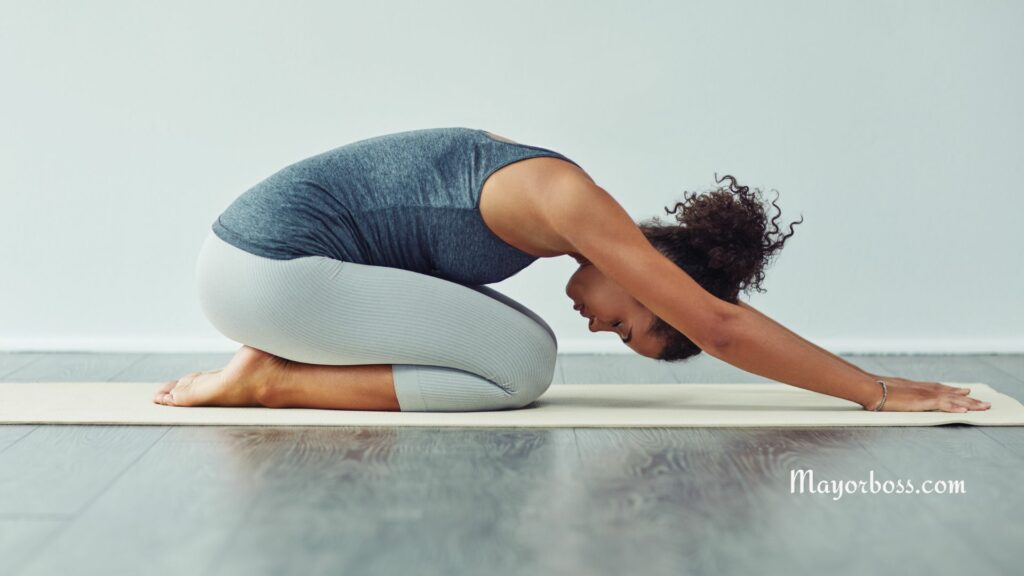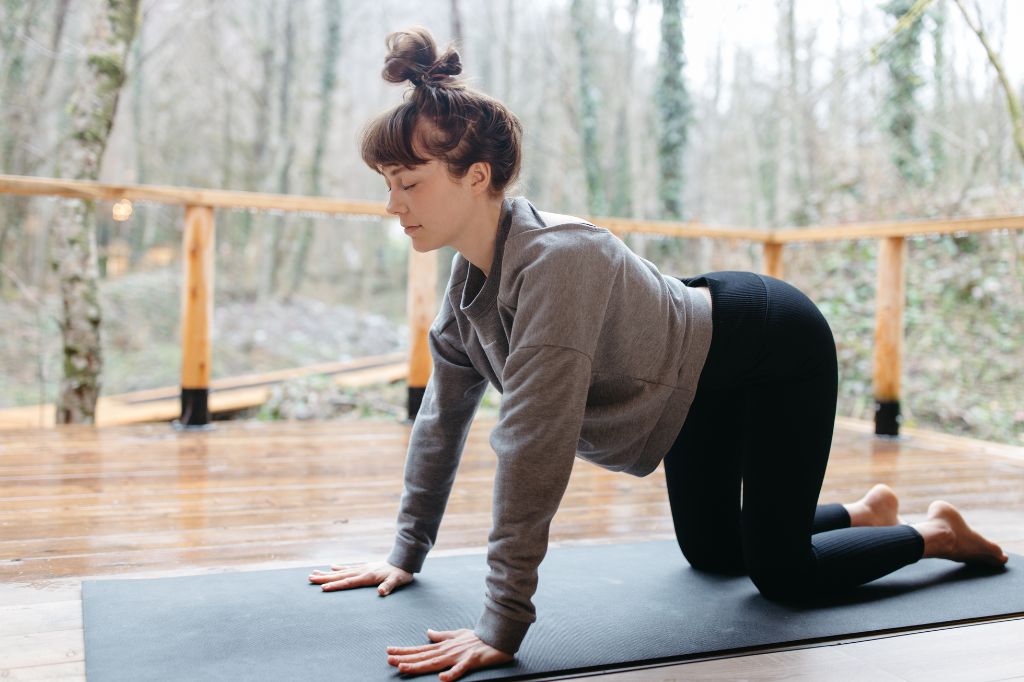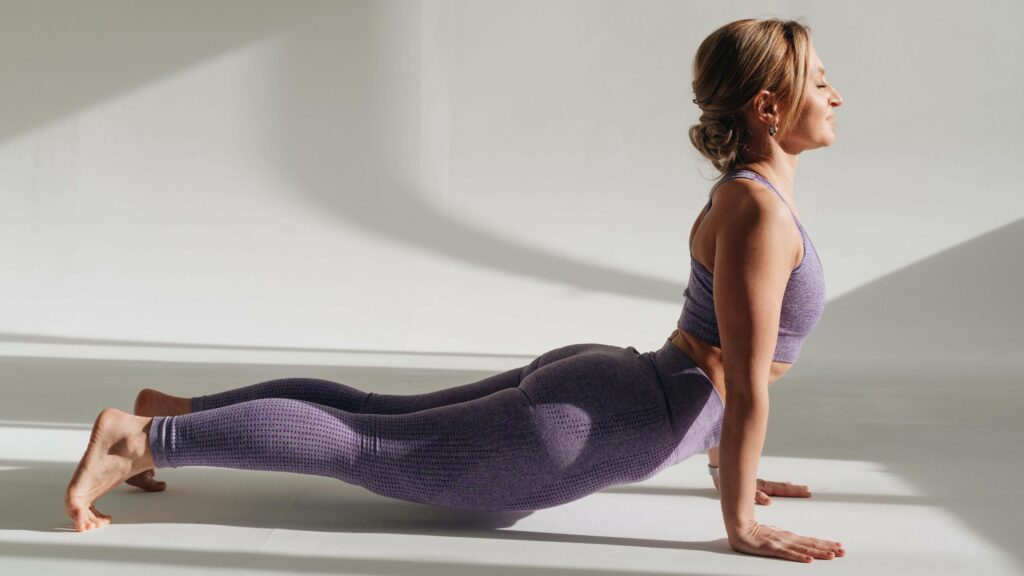The Benefits of Yoga
What is Yoga?
Yoga is a physical, mental, and spiritual practice that originated in ancient India. It incorporates a series of postures (asanas), breathing exercises (pranayama), meditation, and ethical principles aimed at promoting overall wellness.
Yoga is known to enhance flexibility, strength, balance, and mental clarity, while also reducing stress and promoting relaxation.
Today, it’s practiced worldwide in various styles, each offering a unique focus and benefit.
From promoting mindfulness to improving physical fitness, yoga offers an integrative approach to holistic well-being.
What Are The Benefits of Yoga

Research shows that yoga offers numerous benefits for physical and mental well-being. Here are great reasons why you should start practicing yoga regularly:
1. Increases Flexibility
Yoga poses stretch your muscles and generally increase your range of motion.
Thus, regular practice can significantly enhance flexibility.
2. Enhances Strength
Yoga isn’t just about flexibility.
Many poses require you to support your body weight in new ways, including balancing on one leg or supporting yourself with your arms, building strength.
3. Improves Balance
Regularly practicing yoga increases proprioception and improves balance, which is particularly important as you age.
4. Boosts Heart Health
From pumping blood to supplying tissues with important nutrients, the heart plays a vital role.
Practicing yoga regularly may help decrease blood pressure, bring down cholesterol levels, and lower heart rate, as well as improve oxygen flow to the heart, which is beneficial to heart health.
5. Promotes Better Breathing
Pranayama, or breath control, is a fundamental part of yoga.
These exercises teach you how to take deeper, slower breaths which can help improve lung function and respiratory endurance.
6. Supports Mental Health
Yoga reduces stress and anxiety, helping to calm the mind.
It can alleviate patterns of negative thinking, providing a break from worries and promoting a sense of peace and mental clarity.
7. Encourages Mindfulness
Yoga hones your concentration and helps you focus on the present moment.
This practice of mindfulness can extend beyond the yoga mat, influencing all areas of your life.
8. Increases Energy
A few minutes of yoga can help invigorate your body and mind, boosting your energy levels.
9. Alleviates Chronic Pain
Many people who suffer from chronic pain conditions find relief through a consistent yoga practice.
Yoga can help ease pain and improve mobility in people with conditions like lower back pain, arthritis, and fibromyalgia.
10. Promotes Better Sleep
Through its physical and mental benefits, yoga can help to improve sleep quality. Regular practice can also help combat insomnia and promote deep, restful sleep.
11. Improves Posture
Yoga aids in the improvement of posture. Practicing asanas helps strengthen core muscles and makes you more aware of your body, leading to better posture.
12. Supports Joint Health
The gentle, controlled movements of yoga can help improve joint health and ease the symptoms of conditions like arthritis.
13. Promotes Healthy Eating Habits
As per studies, practicing yoga can help you become more mindful of your eating habits, which can lead to healthier food choices.
14. Increases Self-Esteem
Through its emphasis on self-acceptance and mindfulness, yoga can help build your self-esteem and self-confidence.
15. Aids Digestion
Yoga poses that twist and compress the abdomen are believed to improve digestion.
16. Boosts Immunity
Yoga can support the immune system by reducing stress hormones that compromise the immune system and by stimulating the lymphatic system to oust toxins from the body.
17. Promotes Happiness
The practice of yoga can increase serotonin levels, which is the hormone associated with feelings of happiness and well-being.
How to Get Started with Yoga

Starting yoga may seem frustrating, but it doesn’t have to be. Here are some simple steps to help you begin your yoga journey.
Step 1: Define Your Goals
Before anything else, define what you want to achieve with yoga.
Are you aiming for flexibility, strength, stress relief, or a mix of these? Your goals will guide your practice.
Step 2: Choose the Right Style
There are various styles of yoga — some are intense and vigorous, others are gentle and relaxing.
Research different yoga styles and pick one that aligns with your fitness level and goals.
Step 3: Gather Your Equipment
You don’t need much to start — just comfortable clothing that allows for movement and a yoga mat.
As you advance, you might want to invest in props like yoga blocks or straps.
Step 4: Learn Basic Poses
Before diving into a class, familiarize yourself with some basic yoga poses.
Understanding how to do poses like Downward Dog, Child’s Pose, and Warrior II will help you follow along more easily.
Step 5: Start with a Beginner’s Class
It’s strongly recommended that beginners start with a class specifically designed for them.
These classes are slower-paced, and the instructor will take time to explain each pose.
Step 6: Listen to Your Body
Remember, yoga is not a competition. Don’t push yourself to do poses that feel uncomfortable.
Yoga is basically all about connecting with your body, so pay attention to its signals.
Step 7: Practice Regularly
Like any other skill, yoga takes practice. Ideally, try to practice yoga a few times a week.
You’ll notice improvements in your flexibility, strength, and peace of mind before you know it.
Step 8: Explore and Experiment
Once you’re comfortable with the basics, feel free to explore other styles, teachers, and techniques.
Yoga is a personal journey — the best practice is the one that suits you.
So, are you ready to start your yoga journey?
Remember, every yogi started where you are right now. Take that first step on the mat and embrace the journey that is yoga.
Don’t believe me? Try it for yourself and see the difference.
Yoga Poses for Beginners

Getting started with yoga can feel overwhelming at first, but mastering a few basic poses can help you feel more comfortable.
Here are some fundamental yoga poses ideal for beginners:
1. Mountain Pose (Tadasana)
This is a foundational standing pose that improves posture and balance.
Stand with your feet hip-distance apart, engage your leg muscles, and reach your arms towards the sky.
2. Downward-Facing Dog (Adho Mukha Svanasana)
A staple in many yoga routines, this pose stretches the entire body.
From a plank position, lift your hips towards the ceiling to create an inverted ‘V’ shape with your body.
3. Warrior II (Virabhadrasana II)
This pose strengthens the legs and arms and opens the chest and hips.
From a standing position, step one foot back and bend the front knee while keeping the back leg straight. Extend your arms out to the sides.
4. Tree Pose (Vrksasana)
Tree pose is great for improving balance. Stand on one foot and bring the sole of your other foot to your ankle, calf, or inner thigh.
5. Child’s Pose (Balasana)
Often used as a resting position, the Child’s Pose helps to stretch the hips, thighs, and back.
From a kneeling position, sit back on your heels and fold forward with your arms extended in front of you or by your sides.
6. Cobra Pose (Bhujangasana)
Cobra Pose strengthens the spine and opens the chest and shoulders.
Lying on your stomach, place your hands beneath your shoulders, push into your hands, and lift your chest off the ground.
7. Corpse Pose (Savasana)
This is a relaxation pose typically performed at the end of a yoga session. Lie on your back, arms and legs extended, and focus on your breath.
Remember, it’s essential to warm up before starting your practice and cool down afterward.
Also, remember to maintain steady breaths as you move through each pose.
Take the time to learn these poses and get comfortable with them.
As you progress, you can start incorporating more challenging poses into your routine.
Don’t rush it – yoga is a journey, not a race. Enjoy the journey as you discover the many benefits yoga has to offer.
Conclusion
Yoga is a holistic practice that brings together the mind, body, and spirit.
It offers numerous benefits, from physical improvements like increased flexibility, strength, and improved posture, to mental enhancements such as reduced stress and increased concentration.
For beginners, the journey into yoga may seem frustrating.
However, with clear goals, the right style, some basic equipment, and a familiarity with a few fundamental poses, you can comfortably embark on your yoga journey.
Practicing regularly will help you experience the profound benefits of yoga.
Remember, yoga is not just about mastering poses — it’s about tuning into your body, calming your mind, and connecting with your inner self.
Whether you aim to boost your fitness, find stress relief, or seek spiritual growth, yoga is a versatile practice that can be tailored to meet those needs.
So, why not roll out your mat and experience the benefits of yoga for yourself?
As you delve deeper into your practice, you may discover that the advantages of yoga extend far beyond the mat and into your daily life.
As the ancient yoga sutras state, “Yoga is the settling of the mind into silence.”
And in that silence, you may find peace and clarity that brings balance to your life. That’s the true power and potential of yoga.
Frequently Asked Questions About Yoga

Is Yoga Suitable for Everyone?
Yes, yoga can be practiced by people of all ages and fitness levels.
Various styles and modifications make it accessible to everyone.
However, if you have specific health concerns, it’s best to consult with a healthcare provider before starting a yoga routine.
What Equipment Do I Need to Start Yoga?
At the very least, you will need a yoga mat.
Some additional optional equipment includes yoga blocks, yoga straps, and a yoga bolster.
All these items help modify poses to your comfort level.
How Often Should I Practice Yoga?
It depends on your goals and schedule.
If you’re just starting, aiming for two to three times a week can help you build flexibility and strength. More advanced practitioners often practice daily.
Remember, consistency is key in yoga.
Can Yoga Help Me Lose Weight?
Yes! Yoga can aid in weight loss and maintenance by enhancing mindfulness, including mindful eating, and by reducing stress, which is often a factor in weight gain.
Furthermore, practicing yoga can assist in burning calories, boosting metabolism, and increasing muscle mass.
However, it should be part of a balanced lifestyle that includes a healthy diet and other forms of exercise.
I’m Not Flexible. Can I Still Do Yoga?
Absolutely! You don’t need to be flexible to start yoga.
In fact, one of the advantages of regular yoga practice is increased flexibility.
So, if you’re not flexible, yoga is a great way to improve! Remember, everyone’s yoga journey is unique — it’s not about comparing yourself to others.






